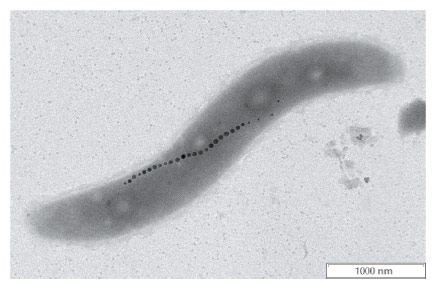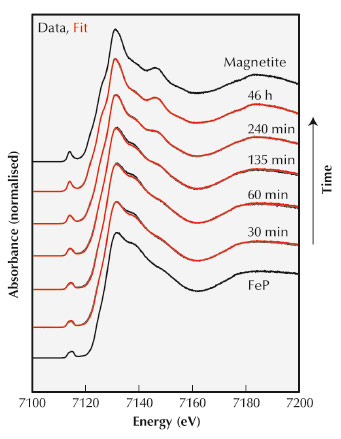- Home
- Users & Science
- Scientific Documentation
- ESRF Highlights
- ESRF Highlights 2013
- Electronic structure and magnetism
- The formation of a biological compass needle
The formation of a biological compass needle
A unique feature of living organisms is their evolutionary acquired adaptation to ecological niches. Consequently, all organisms specialise in a very specific set of nutrient sources prevalent in their natural environment and they try to avoid unfavourable conditions such as predators or toxic conditions. When they find themselves in the wrong surrounding they respond, if they can, by migrating.
Migratory behaviour is known for many higher animals such as birds, mammals and fish. Animals use all kinds of sensory information to reach decisions about when and where to migrate. Maybe the most impressive examples are given by migratory birds that can navigate accurately over thousands of kilometres in the search for reliable food sources.
At a very basic level, this ability to ‘migrate’ upon a sensory input is already ingrained in single cellular organisms and some of the cells in our bodies. These cells are able to sense chemicals through receptors and, upon recognition of a nutrient, can move towards its source, or in the case of a poisonous compound, move away from it. This behaviour is termed chemotaxis.
Aquatic bacteria found in the environment also populate very specific niches and use chemotaxis to find a suitable habitat in their surroundings. One of the most important discriminators in bodies of water is the oxygen concentration. Some species require high oxygen concentrations and are therefore primarily found close to the water’s surface, while for others oxygen is toxic and they are found preferentially near the bottom. Some bacteria, called microaerophiles, require intermediate environments with rather low but still sufficient oxygen concentration. These conditions can be met in very narrow layers in the water column that are found at specific distances from the surface where oxygen diffuses into the water.
However, for a bacterium, the task to find its habitat in a three dimensional environment can be fairly challenging. Brownian motion and other disturbances force these organisms on a random walk against which the bacteria have to struggle with great effort. But evolution has helped some of the microaerophiles a little: they found a ‘trick’ to perform the search more efficiently. These are the magnetotactic bacteria, which have the ability to use the geomagnetic field to assist their navigation towards their favoured habitat zones. Because the field lines in the northern and southern hemispheres are inclined with respect to the Earth’s surface, they provide a vector that helps the bacteria to find the direction to the right conditions. This ability is owed to the formation of intracellular organelles called magnetosomes, which are linearly aligned vesicles filled with the magnetically susceptible iron oxide magnetite (Figure 91). In an external magnetic field, this intracellular “compass needle” orients the whole cell in the direction of the field vector. The bacteria now only need to swim up or down the field instead of randomly choosing a path.
 |
|
Fig. 91: A magnetotactic bacterium with its intracellular magnetosome organelles, a biological compass needle. |
To study the mineral formation that enables this behaviour, we conceived an experiment in which the bacteria were starved of iron to suppress the formation of the particles. The bacteria were then supplied with an iron source to follow the time course of particle formation and to investigate potential intermediates in the process.
The high brilliance of beamline ID26 allowed us to study the minutest amounts of iron in the bacteria during the earliest mineralisation stages by X-ray absorption spectroscopy (Figure 92). We found that the organisms rapidly accumulate iron from their environment and store it intermediately in an amorphous ferric phosphate compound, most likely a bacterial ferritin, a protein for iron storage. We were able to elucidate its chemical structure and to observe the subsequent transformation over time into the iron oxide magnetite. As magnetite is a mixed-valence compound containing both Fe(II) and Fe(III), we could follow the reductive chemical reaction from the ferric precursor by XAS. Further studies by complementary microscopy techniques revealed the distribution of the iron species involved within the organism. This knowledge can now be used to help interpret the roles of various genes suspected to play a part in the formation of the biological compass needle.
 |
|
Fig. 92: X-ray absorption spectra from various stages in the mineralisation process. |
Birds and other animals are also able to navigate using the geomagnetic field. Although our knowledge about their sensory systems is still very limited, understanding of the bacterial systems might provide a basis for studies of such organisms as well.
Principal publication and authors
J. Baumgartner (a), G. Morin (b), N. Menguy (b), T. Perez Gonzalez (a), M. Widdrat (a), J. Cosmidis (b) and D. Faivre (a), PNAS 110, 14883-14888 (2013).
(a) Department of Biomaterials, Max Planck Institute of Colloids and Interfaces, Potsdam (Germany)
(b) IMPMC, UPMC, Paris (France)



